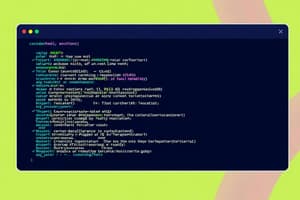Podcast
Questions and Answers
Which HTML element is used to define a block of text that starts on a new line?
Which HTML element is used to define a block of text that starts on a new line?
- ``
- ``
- ``
- ``
What are HTML elements composed of?
What are HTML elements composed of?
- Opening tag only
- Closing tag only
- Opening and closing tags (correct)
- Attributes only
Which of the following is not an input element in HTML forms?
Which of the following is not an input element in HTML forms?
- `` (correct)
- `` (correct)
- `` (correct)
- `` (correct)
What does HTML provide a framework for?
What does HTML provide a framework for?
Which type of elements are essential for enabling user interactions and data collection?
Which type of elements are essential for enabling user interactions and data collection?
What role do HTML tags play in a webpage?
What role do HTML tags play in a webpage?
Which attribute in HTML specifies the URL for an image file?
Which attribute in HTML specifies the URL for an image file?
How do HTML tags typically come in pairs?
How do HTML tags typically come in pairs?
Which HTML element is used to create a heading?
Which HTML element is used to create a heading?
What purpose does a well-structured HTML document serve?
What purpose does a well-structured HTML document serve?
Flashcards are hidden until you start studying
Study Notes
Understanding HTML: Tagging the Web's Content
HTML, or Hypertext Markup Language, is a foundational technology of the modern web. Although it may seem simple at first glance, it's a powerful and intricate language that allows us to create rich content experiences. In this article, we'll explore the building blocks of HTML: HTML tags, attributes, structure, elements, and HTML forms.
HTML Tags
HTML tags are the instructions embedded within the text that tell the browser how to display and organize content on a webpage. Tags come in pairs, opening and closing, and serve as containers for individual pieces of content or groups of content. For example, the <h1> tag is used to create a heading, and the closing </h1> tag tells the browser that the heading content has ended.
HTML Attributes
HTML attributes provide additional information about the content within a tag. For instance, the src attribute in the <img> tag specifies the URL for an image file, and the href attribute in the <a> tag sets the URL for a link. Attributes are placed within the opening tag like this: <tag attribute="value">.
HTML Structure
A well-structured HTML document helps browsers and search engines better understand the content and organize it in a logical way. The structure is built using HTML tags like <html>, <head>, <title>, <body>, and others. Here's a basic HTML structure:
<html>
<head>
<title>My First Webpage</title>
</head>
<body>
<h1>Hello World!</h1>
</body>
</html>
HTML Elements
An HTML element is a combination of an opening and closing tag, and may contain other elements, content, or attributes. HTML elements are the building blocks of web pages, and they help define the content's structure, appearance, and behavior. For instance, the <p> or <paragraph> element is used to define a block of text that starts on a new line.
HTML Forms
HTML forms are used to create interactive elements on a webpage, allowing users to input data and submit it to a server for processing. Forms are composed of input elements such as <input>, <textarea>, <select>, <option>, and others.
To summarize, HTML is a markup language that provides a framework for structuring content. By using tags, attributes, and elements, we can create visually appealing and interactive webpages. HTML forms are an essential feature, enabling user interactions and data collection.
Now that you've completed this introduction to HTML, you're ready to start creating your own web pages. Keep exploring and learning, as the web has an endless array of fascinating content to discover and share!
Studying That Suits You
Use AI to generate personalized quizzes and flashcards to suit your learning preferences.




